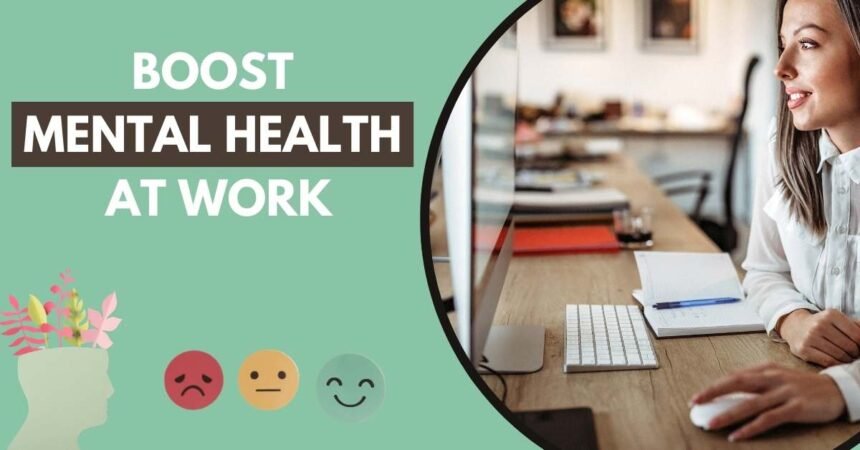Boost Mental Health at Work : In recent years, we’ve seen a big push for mental health in the workplace. This is because the pandemic has made many of us feel more anxious, depressed, and stressed at work. Did you know that 60% of workers feel anxious, and 56% feel depressed1? It’s a big issue that affects everyone at work.
It’s not just a personal problem. The world loses about 12 billion working days each year because of depression and anxiety. This costs a huge US$ 1 trillion in lost productivity2. These numbers show we really need to focus on making work a healthier place and spreading the word about mental health. By working together, we can make our workplaces better and boost productivity.
Even though we’re paying more attention to mental health, many workers still don’t feel better. As bosses, we need to do more. We can help by making work environments supportive, promoting balance between work and life, and offering mental health resources. This can really help improve how well people do at work and make our companies more successful.
Key Takeaways
- 60% of workers experience anxiety, and 56% experience depression1.
- Globally, 12 billion working days are lost annually due to depression and anxiety2.
- Mental health is crucial for maintaining workforce productivity and resilience.
- Investing in mental health resources and fostering a healthy workplace are essential steps.
- Promoting work-life balance can significantly reduce stress and prevent burnout.
Understanding the Importance of Mental Health in the Workplace
Mental health is key in the workplace because it affects both employees and the company’s success. With more people feeling anxious and depressed, especially after Covid-19, employers must act. Depression costs over $51 billion a year in lost work and treatment, and another $26 billion in direct treatment costs in the U.S3..
Why Mental Health Matters
Poor mental health at work has big consequences. With millions working long hours, a lack of focus on mental health can affect many. Nearly 39% of workers say their job harms their mental health4. Depression can reduce thinking skills by 35% and make physical tasks harder 20% of the time3. But, supporting mental health through policies helps everyone, including the company5.
The Impact on Productivity
Mental health and work efficiency go hand in hand. Bad work environments lead to more missed days and less productivity, especially for those with depression3. Stress costs the U.S. up to $187 billion a year, mostly from job stress4. Yet, supportive companies with open communication see better work and smarter decisions from their teams5. So, focusing on mental health boosts employee happiness and helps the company too.
Creating a Supportive Work Environment
Making a workplace mentally healthy takes effort to build a caring work culture. Studies show how important it is to have support at work. This support can greatly improve mental health and work performance.
Fostering a Positive Culture
Creating a caring work culture is key. The APA’s 2023 survey found 92% of workers think it’s crucial to work where emotional and mental well-being is valued6. Also, focusing on mental health can make a team up to 12% more productive7. Training managers to handle mental health issues can cut down on leaving work early and missing days6. This keeps the workplace supportive and welcoming for everyone.

Encouraging Open Communication
Talking openly about mental health builds trust and strengthens support at work. Many fear being judged or feeling ashamed, so they don’t share their mental health issues. This can hurt the whole team’s well-being7. By encouraging open talks, we can build trust and help people get the mental health help they need. The APA says younger workers often feel stressed, lonely, and not valued, showing we need a strong support network6.
If you found this helpful, you might also like our article on “Boost Mental Clarity and Focus: Expert Tips“.
Ways to Improve Mental Health at Work
Improving mental health at work is a big task that needs careful planning. It’s about making mental health improvement, building employee resilience, and creating a productive workplace. The CDC says 67% of workers feel more stressed now, showing we must act fast8.
Training managers to spot when employees are struggling is a smart move. Studies show that when leaders get involved in health issues, everyone gets better. This leads to less healthcare costs, more work done, and happier workers8. Managers have a big impact on how workers feel, more than doctors or therapists9. When managers and employees get along, everyone’s mental health improves.
Talking openly about mental health is vital. The American Psychological Association’s 2023 Survey found 92% of workers want to work for supportive companies9. Having places to talk, like team meetings or surveys, helps build a supportive work culture.
Reducing job stress is about more than just talking. Employers can use mindfulness to help workers feel less anxious and more focused. Flexible hours and remote work also help balance work and life, which is very important9.
Almost all big companies offer Employee Assistance Programs (EAPs) for mental health, but more people need to know about them8. Leaders should make sure to share these resources and encourage people to use them. This shows the company cares about mental health.
Not dealing with mental health costs the world $1 trillion a year due to lost work, being absent, and leaving jobs10. So, focusing on mental health is good for workers and helps the company too.
By using these strategies, companies can make a better place to work. This leads to more engaged workers, less missing work, and happier jobs. For more tips, check out this Forbes article on how to improve mental health at work8.
Implementing Mindfulness Exercises
Mindfulness exercises can make employees healthier by cutting down stress, improving focus, and boosting overall well-being. Adding mindfulness to the workday can make the workplace more peaceful and productive.
Benefits of Mindfulness
Mindfulness has many benefits for whole-person health. It helps with stress, anxiety, depression, and even physical issues like high blood pressure and chronic pain11. Workers who practice mindfulness do better at their jobs and produce quality work. For example, cutting down on multitasking led to big productivity gains12. Also, brain scans show changes after just 30 minutes of mindfulness each day for eight weeks12.

Practical Mindfulness Techniques
To bring mindfulness to work, try guided meditations, mindful breathing, and body scans. These can be part of daily routines to lower anxiety and sharpen focus. Programs like Mindfulness-Based Stress Reduction (MBSR) and Mindfulness-Based Cognitive Therapy (MBCT) help manage stress and prevent depression from coming back11. At places like Google, mindfulness training helps employees handle work stress, making them calmer and more productive12.
Simple mindfulness exercises like focusing on breathing and staying in the moment during breaks are key. They’re great for mental health, improve thinking skills, and help create a positive work culture. By offering resources and encouraging people to join in, we help our team members get better mental health and do their jobs better.
| Technique | Benefits | Evidence |
| Guided Meditation | Reduces stress, enhances focus | Functional MRIs show brain transformation in 8 weeks12 |
| Mindful Breathing | Improves cognitive function | Linked to increased productivity and reduced anxiety12 |
| Body Scan | Promotes relaxation | Improves overall well-being11 |
| Mindfulness-Based Cognitive Therapy (MBCT) | Prevents depression relapse | Combines mindfulness with CBT11 |
| Mindfulness-Based Stress Reduction (MBSR) | Manages stress effectively | Effective even with anxiety symptoms11 |
By using these techniques, we not only reduce stress and improve focus but also make the workplace healthier and more supportive. For more info on managing stress and mental health exercises, check out Health Point Plaza.
Effective Stress Management Techniques
Managing workplace stress is key to a healthy work life and boosting productivity. Many stress relief methods work well and help employees become more resilient. It’s important to understand how work stress affects us before we can manage it well.
About one in ten UK adults feel hopeless about money, and 35% feel anxious, with nearly 30% stressed13. The APA’s survey shows work is a big stress source for many Americans14. Work stress can cause headaches, stomachaches, sleep issues, anxiety, insomnia, high blood pressure, and weaken the immune system14. To fight these effects, companies need to act to lessen stress and help employees feel better.
There are many ways to manage stress, from personal habits to company-wide actions. Personal methods like meditation, deep breathing, and mindfulness can cut stress14. A 2022 Gallup report found workplace stress hit a record high, showing we need these methods more than ever15. Encouraging exercise and relaxation helps too. These activities boost mental health and physical health by lowering blood pressure and strengthening the immune system.
Big changes at work also help with stress. Flexible hours and better work-life balance can ease job stress14. Training leaders and awareness programs help employees bounce back from stress. Studies show teams with anxious leaders are 62% more likely to leave and 56% more likely to stop caring15. So, training managers to handle stress well and offering wellness support can make teams happier and more productive.
In conclusion, a healthy work life comes from good stress relief and support at work. By tackling workplace stress early, companies can make a positive place that helps both mind and body.
| Stress Management Technique | Benefits |
| Meditation and Deep Breathing | Reduces anxiety, enhances focus |
| Employee Wellness Programs | Improves mental health, decreases sick days |
| Flexible Working Hours | Promotes work-life balance, reduces stress |
| Leadership Training | Builds resilience, improves team dynamics |
Promoting Work-Life Balance Strategies
Improving work-life balance is key to making employees happy and productive. Companies that focus on this see big wins for their teams and the whole organization. By offering flexible hours and remote work, businesses help their employees feel better and work in a healthier way.
Flexible Working Hours
Flexible working hours help a lot with work-life balance. When employees control their schedules, they’re happier and less stressed. For example, Microsoft uses flexible work setups to help people blend work and life smoothly16. This approach boosts employee power and makes the team more adaptable and productive.
Remote Work Options
Remote work is another big win for balance. Many studies show it makes people more productive and less stressed. With over a quarter of Americans feeling super stressed, remote work helps manage work and life better17. Companies like Salesforce support remote work and mental health to cut down on missing work and boost happiness16.
These strategies keep top talent and promote lasting work habits. By letting employees balance work and life, companies lower turnover, absenteeism, and boost morale18.
Providing Mental Health Resources for Employees
Having accessible psychological resources is key for supporting employees and making the workplace healthier. Since Covid-19 started, 42% of workers worldwide saw their mental health get worse19. It’s vital for companies to match their health insurance with laws like the Mental Health Parity and Addiction Equity Act. This makes sure wellness programs are as good as physical health care20.
Accessible psychological resources are a big help for workers’ health when companies check their policies and give mental health days21. Mental health groups at work can help spread awareness, build community, and give support. This leads to a culture that talks openly about mental health and wellness19. It’s also important to train managers to support their team’s mental health, creating a caring work environment21.
Encouraging self-care is key too. This includes stress reduction, exercise, healthy eating, and better sleep habits21. Training leaders and staff on mental health in the workplace is crucial. It helps with early action and prevention19. By talking openly about mental health and offering good resources, we can make a workplace that cares for everyone’s well-being.
Employee Assistance Programs and Their Benefits
Employee Assistance Programs (EAPs) offer support to help employees deal with life’s challenges. They provide confidential counseling, stress management tools, and mental health referrals. This means employees know they have support at work. On average, a company with 1,000 employees might see 45 people getting EAP counseling, with 113 total sessions22. Of these, 36 would be employees and 9 family members.
These programs show a company cares about its workers’ mental health. They are key to building a supportive workplace.
How to Access EAPs
It’s important for employees to know how to get help from EAPs. They can get three to 10 counseling sessions for free each year23. EAP services are free for employees and can be reached in person, over the phone, or online22.
Employers can make EAPs more effective by linking them with health and productivity programs. They should tell new employees about the EAP during orientation23. Offering phone and text support can help employees who have busy schedules or can’t get to counseling23.
Success Stories of EAPs
EAP success stories show how these programs can change lives. When employers promote these services, more employees use them, leading to better morale and productivity. Companies can also make sure everyone knows about EAPs by including diversity and inclusion in their messages23.
When employees move from EAP to more extensive health benefits, it shows EAPs work well together with other support systems23. Sharing stories of mental health success can help reduce the stigma around mental health. It encourages more employees to get help.
Employee support services greatly improve mental health in the workplace. This benefits the whole company.
FAQ
Why is mental health important in the workplace?
Mental health is key in the workplace. It affects how well employees do and how the company performs. Happy and healthy employees work better and are more productive.
How can we foster a positive culture at work?
Creating a positive work culture means making a healthy workplace. Encourage talking about mental health and build a strong support system. Training on mental health and promoting self-care helps too.
What are some effective ways to improve mental health at work?
To boost mental health at work, train managers to spot signs of stress. Encourage talking about mental health. Use mindfulness and offer stress management tools and support.
What are the benefits of mindfulness in the workplace?
Mindfulness at work lowers stress, improves focus, and boosts overall well-being. Techniques like meditation and deep breathing help. They make work better and more peaceful.
What are some practical mindfulness techniques for employees?
Employees can try guided meditations, mindful breathing, and body scans. These help reduce stress and improve focus. They make mental health and productivity better.
How can organizations implement effective stress management techniques?
Companies can reduce stress by offering exercise and relaxation strategies. Train leaders, provide stress relief tools, and make work safer and more independent for employees.
What strategies can promote work-life balance?
Flexible hours, remote work, and giving employees control over their work help balance work and life. These reduce stress and make jobs more satisfying.
What mental health resources should companies provide for their employees?
Companies should give mental health resources like counseling, stress programs, and support through health insurance. This follows laws like the Mental Health Parity and Addiction Equity Act.
What are Employee Assistance Programs (EAPs) and how do they benefit employees?
EAPs offer confidential counseling and stress help. They support employees with personal and work issues. This improves overall well-being.
How can employees access EAPs?
Employees can find EAPs through HR or online. Info on how to use them is shared during orientation or in company updates.
Can you share some success stories of EAPs?
EAP success stories show better morale, less absenteeism, and more productivity. Sharing these stories encourages others to use EAPs, reducing stigma and promoting mental health care.
Source Links
- How to Improve Mental Health in the Workplace | Champion Health – https://championhealth.co.uk/insights/how-to-promote-mental-health-wellbeing-in-workplace/
- Mental health at work – https://www.who.int/news-room/fact-sheets/detail/mental-health-at-work
- The Importance of Mental Health in the Workplace – https://www.springhealth.com/blog/importance-of-mental-health-in-the-workplace
- Why mental health needs to be a top priority in the workplace – https://www.apa.org/news/apa/2022/surgeon-general-workplace-well-being
- How to Improve Mental Health in the Workplace – https://naspweb.com/blog/how-to-improve-mental-health-in-the-workplace/
- 5 ways to improve employee mental health – https://www.apa.org/topics/healthy-workplaces/improve-employee-mental-health
- How to support mental health at work – https://www.mentalhealth.org.uk/explore-mental-health/publications/how-support-mental-health-work
- 6 Ways On How To Improve Mental Health In The Workplace – https://blog.corehealth.global/6-ways-on-how-to-improve-mental-health-in-the-workplace
- Supporting Mental Health in the Workplace | Blogs – https://blogs.cdc.gov/niosh-science-blog/2024/04/15/workplace-mental-health-resources/
- Mental Health in the Workplace – HelpGuide.org – https://www.helpguide.org/articles/work/mental-health-in-the-workplace.htm
- How to look after your mental health using mindfulness – https://www.mentalhealth.org.uk/explore-mental-health/publications/how-look-after-your-mental-health-using-mindfulness
- 10 Tips to Implement Mindfulness in the 2024 Workplace – https://www.wellsteps.com/blog/2020/02/11/mindfulness-in-the-workplace/
- How to manage and reduce stress – https://www.mentalhealth.org.uk/explore-mental-health/publications/how-manage-and-reduce-stress
- Coping with stress at work – https://www.apa.org/topics/healthy-workplaces/work-stress
- Stress Management For Leaders, Improved Mental Health For The Workplace – https://www.forbes.com/sites/onemind/2023/04/25/stress-management-for-leaders-improved-mental-health-for-the-workplace/
- Health and wellness in the workplace: Promoting work-life balance – https://onlinemba.ku.edu/mba-blog/promoting-work-life-balance
- Work Life Balance – https://www.mhanational.org/work-life-balance
- Council Post: Five Strategies For Improving Work-Life Balance – https://www.forbes.com/sites/forbesbusinesscouncil/2023/02/27/five-strategies-for-improving-work-life-balance/
- 8 Ways Managers Can Support Employees’ Mental Health – https://hbr.org/2020/08/8-ways-managers-can-support-employees-mental-health
- Mental Health at Work – https://www.dol.gov/general/mental-health-at-work
- Access Mental Health Resources for Your Employees – The Edge from the National Association of Landscape Professionals – https://blog.landscapeprofessionals.org/access-mental-health-resources-for-your-employees/
- Workplace Mental Health – Employee Assistance Programs – https://www.workplacementalhealth.org/mental-health-topics/employee-assistance-programs
- How Your Employee Assistance Program Supports Mental Health – https://woodruffsawyer.com/insights/eap-supports-mental-health
















